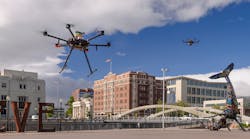NASA recently announced its 2020 invention and software awards, courtesy of its Inventions and Contributions Board. The space agency selects a government and a commercial invention for the award. The 2020 government invention of the year is for a new unmanned air traffic management (UTM) system that will help steer growing numbers of unmanned aerial vehicles (UAVs) in crowded airspaces. Developed by a team at NASA’s Ames Research Center (Moffett Field, CA), the system (see figure) has been developed to control what is expected to be more than 700,000 unmanned aerial systems (UAS) or drones in low-altitude airspace along with the existing traffic in that airspace. The system will enable the use of drones for medical and delivery applications without interfering with helicopters and low-flying air traffic in the vicinity of airports.
The patented, cloud-based UTM differs from the air traffic control systems used by the Federal Aviation Administration (FAA) for commercial air flights. The UTM is based on digital data sharing of each user’s planned flight details, so that each user has the same situational awareness of airspace. The invention, which is part of a multiple-year research project, relies on a long-standing close relationship between NASA and the FAA. The UTM development project also involves more than 100 research partners in government, industry, and at universities.
“At NASA, we believe technology drives exploration, and our talented innovators are key to our continued leadership in space and technology. Each year we evaluate our inventions based on how they have benefitted NASA and other industries and recognize the great people behind the technologies,” said Douglas Terrier, NASA’s chief technologist. “The technologies we recognize with this year’s awards will have lasting impacts on the way we transport goods, build cars and space stations, and enable audacious missions to accomplish NASA’s most ambitious goals.” NASA’s 2020 commercial invention of the year, developed by NASA’s Johnson Space Center (Houston, TX) working with General Motors, is for a robotic technology known as RoboGlove. It is an active exoskeleton robotic aperture that provides high resolution and precision in place of, or in addition to, a biological appendage.
